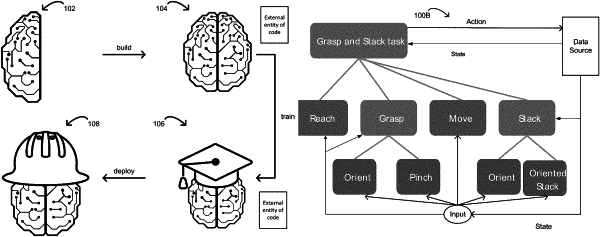| CPC G06Q 10/00 (2013.01) [G06F 3/0482 (2013.01); G06F 8/31 (2013.01); G06F 8/311 (2013.01); G06F 8/38 (2013.01); G06F 9/451 (2018.02); G06F 9/4881 (2013.01); G06F 15/80 (2013.01); G06F 16/2228 (2019.01); G06F 16/951 (2019.01); G06F 18/2148 (2023.01); G06F 30/20 (2020.01); G06N 3/008 (2013.01); G06N 3/04 (2013.01); G06N 3/045 (2023.01); G06N 3/08 (2013.01); G06N 3/105 (2013.01); G06N 5/04 (2013.01); G06N 20/00 (2019.01); G06V 10/945 (2022.01); G06V 10/96 (2022.01); H04L 67/01 (2022.05); G06F 3/03543 (2013.01); G06F 30/333 (2020.01); G06F 40/166 (2020.01)] | 20 Claims |

|
1. A computing device, comprising:
a processor; and
a memory storing instructions executable by the processor to:
execute multiple independent modules of an Artificial Intelligence (“AI”) engine on one or more computing platforms, the multiple independent modules comprising an architect module;
use the architect module to create a plurality of nodes that are connected in a graph of concept nodes to form a resulting AI model, where the graph of the concept nodes is derived from a description in one or more scripted files;
create a first concept node based on a preconfigured function or a pre-trained AI object by wrapping an external entity of code into a software container with an interface configured to exchange information in a protocol of a software language used by the external entity of code;
create a second concept node comprising a new AI object that is coded by the architect module in the graph of the concept nodes that is derived from its description in a first scripted file; and
connect the second concept node into the graph of the concept nodes in the resulting AI model, where a re-use of the external entity of code as the first concept node in the graph allows creation and training of the resulting AI model with less computing cycles than creating and training all of the concept nodes in the resulting AI model from scratch; and
where the second concept node allows deployment of the first concept node embodied in the external entity of code with i) new functionality, ii) extended functionality or iii) a combination of both when combined in the resulting AI model.
|